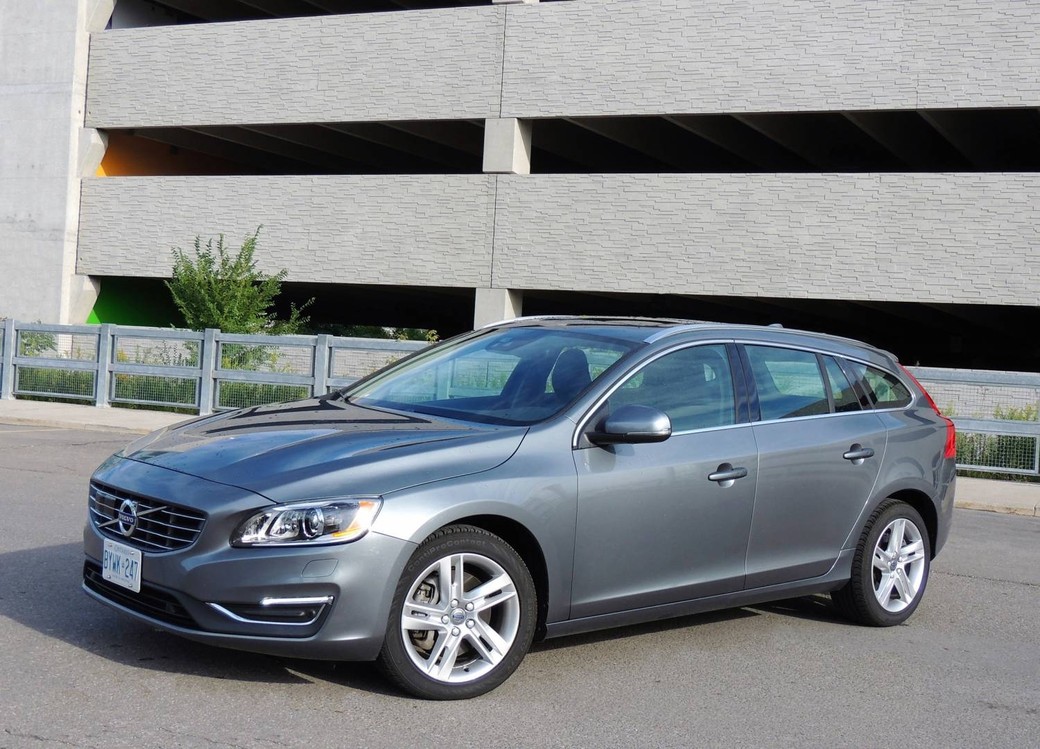
Volvo V60 is a Wagon for the Driving Enthusiast
It appears we’ve forgotten how to travel lightly.
I have nothing against SUVs and crossovers, but with nearly two-thirds of today’s vehicle purchases being some form of truck, it begs the question: do most of us really need this much vehicle?
I’m not sure how many hockey bags today’s smallish families need to haul, nor if they spend much time off-roading with all that ground clearance. Either way, the belief that “less is more” is clearly no more.
I’ve often heard it said: “I like a commanding view of the road.”
Uh, yeah… With the vehicle ahead likely being another freakin’ sport utility, I’m not buying it.
Which leads to my point that wagons should be making more of a comeback.

Not the lumbering Roadmasters and faux wood-panelled Country Squires of decades past. Their fondness for petrol, barge-like handling, and ability to rust overnight would do little to advance my argument. Instead I’m talking about the wagon’s modern interpretation, as seen in Audi A4 allroad, BMW 3 Series Touring and Mercedes E-Class.
These deliver an alchemy of performance and practicality that evades most SUVs. Keeping in mind that a high centre of gravity isn’t your friend when it comes to agility.
No less capable than any of the above is Volvo’s V60, my tester for the week.
The Swedish automaker has had a long history of building stout and reliable wagons that were “as sleek as the box they came in.” The running joke, however, ended around Y2K when Volvo discovered the curve and began using it slightly more with each generational change.
Today, the product lineup has found its mojo, and no more so in the V60 and its variants.
This mid-size sport wagon starts at $40,600 for the T5 Drive-E FWD, topping out at $53,000 (plus options) for the T6 Drive-E AWD R-Design.
The cryptic nomenclature indicates a plethora of drivetrains, including the base model that gets a 2.0-litre turbo four cylinder (240 hp, 258 lb/ft), a T5 AWD with 2.5-litre turbo five cylinder (250 hp, 266 lb/ft), T6 AWD models powered by either a 2.0-litre with turbo and supercharger (302 hp, 295 lb/ft, as tested) or with 3.0-litre inline six (300 hp, 325 lb/ft). And finally the top-trim R-Design gets a potent turbo 3.0-litre that delivers 325 hp and 354 lb/ft of torque, but that’s being replaced by the turbo/supercharged four cylinder.
What they all have in common is a look that’s more coupe than estate car.
Volvo’s signature grille with large “iron mark” logo is flanked by projector headlamps that sweep back into a “double-wave” character line following the V60’s high and rising beltline. With its long bonnet, steeply-raked windshield and rear-sloping roofline, its profile is lithe and athletic.
By opting for a wedge rather than box shape, the V60 does present a few compromises, such as narrowing windows towards the rear and a decent, but not huge, cargo capacity of 430 litres. That expands to 1,241 litres with the 40/20/40 second-row folded flat, not angled up like many other vehicles.
Interior volume, despite the tapered cabin, is generous, with reasonable head and leg room for rear passengers. What I like here is the separately folding middle seat that drops to allow longer objects – like skis and lumber – to pass through so that two can still ride comfortably.

Another handy feature is the standard-equipped power folding headrests. They may seem gimmicky, but with smallish back windows, flopping them forward sure aids visibility. And they’re handy for bonking a rambunctious teenage son in the head, according to his younger sister.
Up front, the ergonomics are good, with the centre stack angled toward the driver. It looks a bit dated compared to some of today’s touchscreens, but the ease of pressing a single button rather than stabbing your way through menus and submenus while driving, more than compensates.
And the multifunction scroll knob works well enough in navigating the infotainment. Sensus provides the usual radio functions, along with built-in WiFi, streaming music, and apps such as Volvo On Call that allows you to start the engine, lock the doors and warm or cool the cabin from your smart phone.
What the company is best known for is safety, and despite a newfound affinity for style, Volvo hasn’t lost any of its ‘bank-vault’ build quality. This you can hear, and feel, in the way the doors close with a solid ‘thunk’ – no tinny rattles.
The V60 is made of boron and lighter steels, making for a robust safety cage to protect occupants and disperse energy during an accident.
And, of course, there’s no shortage of safety tech to help prevent these mishaps. Like City Safety that precharges the brakes for a quicker stop, or automatic braking if it senses a crash is imminent.
The system also detects pedestrians and cyclists, neither of whom would ever cut in front of moving vehicles. But in case they do, City Safety will warn with a light on the windshield and even apply the binders if needed.
My tester, the T6 Drive-E AWD starting at $47,900, falls pretty much in the middle of the V60 range.
It comes with premium content like leather seating (power up front with memory for the driver), power sunroof, pushbutton start, 18-inch alloys, stop-start technology (annoys but saves fuel) and the previously mentioned Sensus infotainment.
It also received a pile of option packages like Climate ($1,350 – includes heated seats, heated steering wheel); Technology ($1,600 – includes adaptive cruise control, collision warning with auto brake, pedestrian and cyclist detection, lane departure warning, road sign info and more); Navigation ($2,950), and Blind Spot info at $1,000 which includes lane change merging aid and parking sensors.

But I’m more of a driving enthusiast than tech geek, and it is here the V60 won’t disappoint. I’ve driven various Volvo powertrains – including the punchy inline fives and straight sixes – but was also impressed with how engineers have employed both supercharger and turbocharger to augment the 2.0-litre four cylinder.
With more than 300 horses on tap, and peak torque coming in at 2100 rpm, there was no shortage of get up and go. Especially in Sport mode with its quicker throttle and later shifts that get the most from the V60’s eight-speed Geartronic automatic with manual shift.
Handling is taut, but not harsh, and steering provides enough feedback to remind you that the V60 is really just a more functional version of Volvo’s potent S60 sports sedan.
Supporting my earlier point that today’s wagon should be getting a little more love. The sport wagon, at least, provides an ideal balance between performance and practicality – and the Volvo V60 is as good as any in this small but competitive segment.
SNAPSHOT: 2016 Volvo V60 T6 AWD Sport Wagon
BODY STYLE: mid-size wagon
ENGINE: (as tested) 2.0-litre inline four cylinder with turbocharger and supercharger (302 hp, 295 lb/ft)
TRANSMISSION: 8-speed automatic manual mode, electronically-controlled AWD
FUEL ECONOMY: as tested, 11.3/8.2/9.9 L/100km (city/hwy/comb)
CARGO: 430 litres (behind second row) 1,241 litres max
PRICING: T5 Drive-E FWD (base) $40,600; T6 Drive-E AWD (as tested) $47,900 plus options
WEBSITE: volvocars.com.









